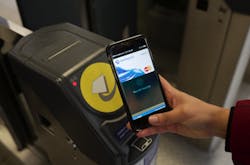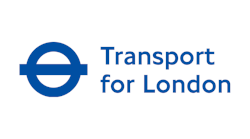Fare collection has always been a necessary aspect of any public transit system, but the ways that agencies go about collecting its fares no longer needs to be a hassle. Having riders purchase fares in stations is a thing of the Stone Age, methods like chip cards and mobile payments are a way of future. Cubic Transportation Systems was awarded a contract with Transport for London (TfL) to overhaul its Oyster card fare system. Cubic and TfL have worked together since 1998. They originally introduced the Oyster smartcard together in 2003 and also developed contactless EMV payments for London's buses, Tube and rail services in 2014.
"The old Oyster card is what we called a closed loop card, which means that the only devices that can read that card, and write to that card and use that card are the readers that are on the TfL equipment. What TfL added to the system was a different type of contactless chip card, which we call an open payment card, which are just like the Visa or MasterCard’s that you have in your wallet today, but it has a contactless interface," explained Rasheed Behrooznia, VP, engineering, Cubic Americas. "It means that you can use your Visa or MasterCard anywhere — that type of a card can now be used when you ride transport in London."
Behrooznia added that riders are able to use their Visa or MasterCard that bares the logo and simply tap it on the reader and the transaction appears on the rider's bank account.
"The customer reaction had been fantastic. Since launching contactless payments we have seen over 18 million unique cards, making over 800 million journeys. That includes cards and phones from around 100 countries, which is phenomenal," said Jonathan Hill, business analyst technology and data team at TfL. "Contactless now accounts for close to 40 percent of all our Pay As You Go journeys, and the share continues to increase week on week. Those numbers speak for themselves, but we also get a lot of positive feedback for embracing new technology and giving customers greater convenience by offering more ways to pay."
Hill explained that London's Tube and rail fares vary by the distance and time that riders travel and the proximity to the city center. Hill said that this means that the cost of the ride is not known until the riders journey has been completed.
Choosing the right payment system
"One of the biggest things we have had to deal with is what we call ‘Card Clash’. When we only accepted Oyster cards, a lot of customers got used to keeping their Oyster in their wallet, and therefore simply touched their whole wallet on the reader. Because the readers now accept contactless bank cards as a well as Oyster, the system has been configured to not perform a transaction if multiple cards are detected, meaning it’s important that customers only present one card to the reader," said Hill.
The partnership with TfL has given Cubic an advantage in furthering its offerings in payment technology. Using TfL's system proved Cubic's ability to reduce the risk and make open systems more efficient.
Matt Newsome, SVP & GM, Cubic Americas said, "The transit agency usually decides how they want to proceed with the card, so they’ve determined in the past whether they wanted magnetic or contactless. Now that magnetic are a thing of the past; they’re now determining whether or not they want the closed loop cards, the account based or the open payment cards. Their decisions for that range from a multitude of reasons, one when you have and open payment type card, anybody who has that card can use it."
Tourists are able to use the system without having to go to a vending machine or counter to purchase a card. Newsome said that transit agencies see their card costs go down, when they do not need to purchase as many different types of card. He said that a flip-side to the lower cost of the cards for the agency is that there are bank fees associated with using the cards. It comes down to the agency to determine which solution works best for their transit system.
"Each agency has their own customer experience that they’re trying to maximize and one type of system needs to be unique to their customer base," added Behrooznia. "Along with that comes a certain payload of information that may or may not be on the card or be transmitted back and forth from the office to the device. An agency will have additional information for payload fit that needs to be communicated."
"To reduce the impact of this change, we did a lot of customer education both before and after launching contactless to highlight the need to choose which card the customer wants to pay with, and present only that card to the reader," explained Hill. "We also regularly monitored for examples of where this happened, and made minor changes to the software to further reduce this as time went on."
Factoring in security
One of the main concerns when it comes to fare payment systems is the security of the users' information. As payment methods further develop to incorporate more technology, it raises the issue about how the companies behind these methods are providing protection for its users.
These new cards come with new standards, EMV standards — which stands for Europay, Mastercard and Visa.
"This takes the level of security even higher. And the nice thing about the closed card systems is that the card can only be used in that one area. But like anything like that there are always little holes and we’re always putting different types of measures and protections, but this is the bank card industry's job," said Newsome. "We have to make sure that our devices are properly certified to read them. We have to make sure that our back offices are properly certified to have the data and through what are called the PCI standards. We have to make sure that our policies and procedures ensure that type of security as well."
To not only protect security, but to also ensure that the system works efficiently, Cubic must come together with all parties that are involved with fare payment. Cubic has a number of systems a mix of both open and closed loop. Newsome said that they are able to create the systems with some fluidity.
Keeping longevity in mind
"Our regular market research shows customer satisfaction with contactless is on par with Oyster, which is a great achievement considering how well known and respected Oyster is in London," said Hill.
As payment methods develop in fare and banking, more people are seeing chip cards in their wallets. Europe has developed these payment methods on a larger scale, but the United States has started rolling out both chip cards and payment through phone apps.
"What we see right now with the cards is that there are different types. Different memory sizes, different security, we certainly keep up to date with those for our customers," said Newsome. "As far as these open payment cards, they’re just now coming into the market. I mean the trends are just going to keep growing, but just like any sort of technology like that, it is also going to be the banks, MasterCard and Visa and how they’re going to flow them out. We watch and try to make sure that we stay insync with it as it comes out." Newsome said that Cubic plans to watch TfL's fare system to see how riders respond and the ease of the use to the transit system.
"The biggest change since launch has been the global take-up of contactless mobile payments. These generally use the same contactless EMV technology we have implemented, so we were able to accept payments from phones with minimal changes. We now accept Android Pay and Apple Pay, as well as mobile payments from American Express, Barclaycard and Vodafone," explained Hill. "Mobile payments have the potential to provide customers with some great additional benefits, such as quicker access to their bank account while travelling as well as live travel information, and we have worked with Google to introduce a range of bespoke features such as incomplete journey notifications into Android Pay. As more companies see the benefit of these innovations, I’m hoping customers will see more features and offers linked to mobile payments, which can only look to improve the payment experience for customers. "




